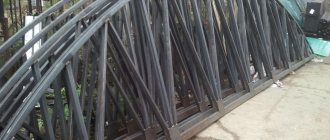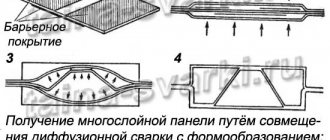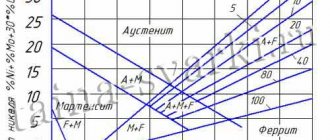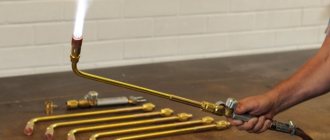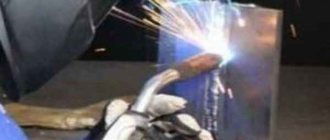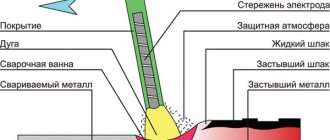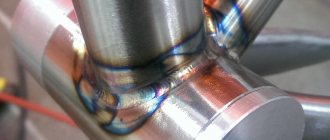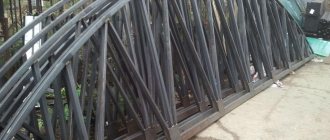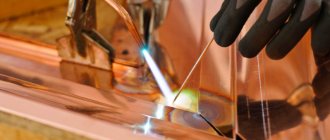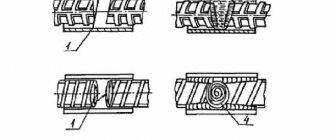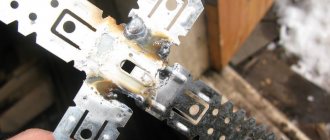Possible defects
When welding titanium, if it is not done with a laser, defects are possible.
According to GOST, defects appear due to non-compliance with technical conditions, violation of technology, after which the design becomes unsuitable. According to GOST, defects are of the following types:
- cracks;
- pores;
- solid formations;
- lack of fusion;
- wrong seam;
- other defects.
Cracks and ruptures in the seam or adjacent areas, according to GOST, are unacceptable, since a center of destruction is created.
The formation of gaps is explained by the high content of carbon, nickel, hydrogen, and phosphorus in the molten metal. When welding with a laser, the probability of crack formation is reduced to zero.
To eliminate cracks, you need to drill the ends of the defect, then eliminate the crack mechanically and by gouging, after which the area is cleaned and welded.
Pores, according to GOST, are cavities filled with gas. Formed due to high gas formation.
The area with pores must be digested, having previously been cleaned mechanically, since the defect weakens the structure.
Solid inclusions according to GOST are foreign metallic and non-metallic substances in the seam, reducing the strength of the seam and concentrating stress, so the area with the defect is cut down to a healthy area and removed by gouging, then welded.
Video:
Non-fusion according to GOST is the lack of connection between the metal and the seam. Formed during arc welding due to non-melting of part of the joint edge.
This can happen if the corner shape is chosen incorrectly, the edges are poorly cleaned, or the welding mode is selected incorrectly. Such defects reduce the strength of the seam. The defect site must be cut out, cleaned and welded again.
Violation of the shape according to GOST - deviation of the shape of the seam from the established requirements.
The causes may be voltage fluctuations in the network, incorrect angle of inclination, etc. The consequence may be internal defects in the seam.
To eliminate the defect, a thin seam is welded with a small-diameter electrode.
Manual process
Welding of alloys with titanium (in general) is carried out with direct current, straight polarity. The current depends on the thickness of the parts being connected, the caliber of the electrode and the diameter of the filler wire, and varies in the range of 90-200 A.
The higher the thickness of the metal, the greater the current supplied. Thus, parts 2 mm thick are connected at a current of 90 A, 3-4 mm - 130-140 A, 10 mm - 160-200 A. It is recommended to use the minimum possible current. The voltage is always the same - 10-15 V.
Electrodes
Non-consumable tungsten electrodes are used, which are sharpened at an angle of 30-45 °C (like a pencil) before starting work. The larger the sharpening angle, the shallower the penetration depth.
If used intensively, the electrode will need to be sharpened again as soon as it becomes dull. Electrodes containing lanthanum oxide are recommended, as their load-bearing capacity is 50% higher than that of pure tungsten products. Thanks to this, the weld will be less contaminated with tungsten, cleaner, and therefore stronger.
Wire
Filler wire is titanium wire of the appropriate alloy; it is selected specifically for the parts to be welded according to special tables. The wire should be annealed under vacuum to remove hydrogen that may be present in the alloy, and in any case it must be cleaned of oxides. The stripped wire is stored in an airtight tube for no more than 5 days.
If you weld metal with a thickness of no more than 1.5 mm using the butt method, then it is not necessary to use wire. A seam without an additive will be even stronger.
Features of the technology
During welding, a constant speed of movement of the electrode is maintained and a continuous supply of additive is ensured. The electrode speed should be approximately 2-2.5 mm/sec. It is necessary to maintain high precision of movements, to avoid vibrations and moving the electrode to the side. The electrode should touch the seam as if from bottom to top, welding proceeds “forward at an angle.”
During the entire process and for about a minute after switching off the burner, shielding gas must continue to be supplied to the fresh seam until the seam temperature drops below 400 °C.
In the welding zone, argon is consumed at a rate of 5-8 liters per minute, on the reverse side of the seam - 2 liters per minute.
When welding titanium pipes, their ends are sealed, and an inert gas - argon, or less often helium - is pumped inside using a special pump.
At home, in the absence of such equipment, it is impossible to weld titanium pipes. An exception is capacitor butt welding of titanium pipes of grade VT1-VT2, with a diameter of no more than 23 mm and a wall thickness of no more than 1.5 mm.
They can be welded outside a protective gas environment, but only using the capacitor method, at a high charging voltage - 850-2100 V.
Gas protection
[context] One of the most important conditions for obtaining a high-quality connection when welding titanium alloys is to ensure reliable gas protection: the weld; areas of the base metal that are heated to 250-300 degrees. You can choose one of three gas protection options:
- inkjet - with the use of special devices;
- local - in sealed chambers of small volume;
- general – in chambers with a controlled atmosphere (UBS-1, VKS-1, VUAS-1).
Rice. 1 Protective chamber for titanium welding
Additional protective devices are made of stainless steel. Gas lenses and splitters must be provided. A special nozzle is attached to the gas torch to protect the crystallizing weld pool. Its width should be 40-50 mm, and its length – 60-120 mm, depending on the welding mode. When welding circular rotary and non-rotary joints, as well as tubular structures, local or small-sized chambers are used.
Rice. 2. Auxiliary equipment to protect the welding area
The quality of protection can be determined by the appearance of the weld metal. If its surface is silver or light yellow, protection can be considered sufficient. A blue-yellow weld indicates a violation of protection, although in some cases such welds are quite acceptable. A bluish-gray and dark blue color indicates a poor-quality seam.
Argon and semi-automatic welding
If all the requirements and rules of argon arc welding are correctly followed, then high strength welds of titanium pipes and other alloy structures can be achieved. If the welding technology is violated, the quality of the connection will noticeably decrease.
Titanium metal, unlike other non-ferrous metals, requires high quality argon. The liquid base of the welded joint must be completely protected from atmospheric air. In addition, the hot area near the seam must be protected during the crystallization process and further cooling to 427 degrees.
The titanium argon welding technology is carried out taking into account the following recommendations:
- argon welding of titanium should be performed using direct current with straight polarity;
- the welding process requires the use of tungsten electrodes;
- Sometimes welding titanium alloys using argon arc welding may require additional devices through which inert gas will flow, displacing air. These elements can have any shape and size;
- Welding with argon is also performed using gaskets made of copper or steel. You can cut holes in them to supply gas;
- The pipes are connected using special aprons. These elements may have various roundings;
- if the connection is made end-to-end or overlapped, with a metal thickness of at least 3 mm, then filler wire may not be used. In these cases, the nozzle is installed at the largest diameter and the degree of argon gas supply is increased;
- Welding titanium with steel should be performed with a short arc, and there should be no oscillatory movements. And the supply of filler rod must be continuous;
- The gas supply must continue for 1 minute after the arc has been extinguished. Performing this action will prevent oxidation of the seam.
Use argon arc welding with caution
It is important to prevent the tungsten electrode from interacting with the weld pool. This will prevent tungsten particles from penetrating into the weld area.
Semi-automatic titanium welding is similar to argon arc welding, but it has increased efficiency and a high degree of productivity when joining workpieces with a thickness of more than 1 cm.
In semi-automatic welding, a current source with reverse polarity is used. The welding torch must be equipped with a remote device to regulate the current levels. This will help prevent serious problems with the welding process.
Titanium alloy is stronger than pure titanium.
Titanium alloy is a special compound based on titanium and a compound of titanium and boron, which is not an ordinary “alloy”, but a special composite material, similar in its structure to a honeycomb of bees or a mosaic. This alloy has a low specific gravity, high corrosion resistance, and hypoallergenicity. Unlike pure titanium, titanium alloy has high strength and hardness.
Description:
Titanium alloy, or more precisely, the titanium-titanium boron composite, like pure titanium, has a low specific gravity, high corrosion resistance, and hypoallergenicity. Unlike pure titanium, titanium alloy has high strength and hardness.
The main disadvantage of titanium is its relatively low hardness, which does not allow titanium to be used as a base for cutting tools or other devices and products that require materials that resist deformation well.
Titanium alloy is a special compound based on titanium and a compound of titanium and boron, which is not an ordinary “alloy”, but a special composite material, similar in its structure to a honeycomb of bees or a mosaic.
The components of this material perform different functions. In particular, the walls of the “honeycomb” of this composite material consist of titanium boride, a stronger and harder material, and the voids between them are filled with ordinary titanium, softer and more flexible than the boron-titanium compound.
Such a very strong and at the same time plastic material based on honeycombs can be obtained by sintering a mixture of titanium and titanium diboride powders at temperatures of approximately 1000 °C. Under such conditions, titanium boride matrices can be processed and deformed without the formation of cracks in their structure.
Advantages:
– high corrosion resistance,
– low specific gravity,
– hypoallergenic,
– non-magnetic material,
– high strength and hardness.
Application:
– production of heavy-duty and lightweight medical and aerospace devices, tools and products,
– production of cutting tools.
Site Map
heat-resistant titanium alloys we will make titanium alloy knife from titanium alloy strength welding composition features of titanium alloys titanium titanium alloys VT state titanium alloys are used titanium titanium alloys buy brands production mechanical properties technology titanium alloys characteristics titanium alloy VT 6 price titanium alloys Japanese knife made of titanium alloy
Demand factor 195
Possible defects when welding titanium with argon and ways to eliminate them
The only way to avoid defects when joining titanium elements with argon is to use a laser; in all other cases, errors are possible. GOST determines that defects appear due to non-compliance with technical conditions, violation of technology, as a result of which the design becomes unsuitable for use.
According to GOST, defects are divided into the following types:
- cracks;
- pores;
- solid formations;
- lack of fusion;
- wrong seam;
- other varieties.
GOST does not allow the presence of cracks in the seam or adjacent areas, since they form the center of destruction.
The reason for the appearance of ruptures usually lies in the high content of carbon, nickel, hydrogen, and phosphorus in the molten metal. Let’s say right away that when joining with a laser, there is no chance of cracks forming. To remove cracks that have appeared, it is necessary to drill the ends of the defect, then eliminate the crack mechanically and by gouging, clean and weld the area.
GOST defines pores as cavities filled with gas. It is quite logical that this defect is formed when welding titanium with argon due to high gas formation. A place with pores weakens the entire structure, so it is digested, having previously been cleaned mechanically.
Solid inclusions are foreign metallic and non-metallic substances included in the weld, reducing its strength and concentrating stress. Therefore, the area with the defect is completely cut down, removed by planing, and welded.
Non-fusion is the lack of connection between the metal and the weld, caused by the failure to melt part of the edge of the joint. This defect can appear if the corner shape or welding mode is chosen incorrectly, or if the edges are poorly pretreated. Since lack of fusion negatively affects the strength of the seam, the defect site is cut out, cleaned, and then welded.
Violation of the shape is a discrepancy between the shape of the seam and the established requirements. This deficiency appears due to power surges in the network, incorrect angle of inclination, etc. It can lead to internal defects in the seam, so they resort to welding the area with a thin seam with a small-diameter electrode.
Titanium welding protection
Titanium welded joints are made under protection, which is necessary until they cool down to a temperature of +427 ° C. In addition, the molten weld pool must also be protected, which will prevent a reaction with air from starting. The most common shielding gases are argon and helium. They are provided by TIG and MIG titanium welding technologies.
Shielding gas is used in several ways at once:
- Primary protection of the molten weld pool.
- Secondary protection of cooling molten metal and heat-affected zone.
- Protection of the reverse side of the weld.
- Primary protection of the molten weld pool. Proper selection of a welding torch allows you to provide high-quality primary protection. So, in order not to disrupt the technology of welding titanium with TIG argon, you will need a torch equipped with a gas lens and a large ceramic nozzle. Using a gas lens, inert gas will be supplied in a uniform flow, and the nozzle will protect the molten weld pool over the entire area. Argon produces a very stable arc, so this gas is often used. If it is necessary to penetrate deeper into the metal or work at a higher voltage, then a mixture of argon and helium can be used.
To determine the effectiveness of the shielding gas and its consumption, preliminary tests can be performed on a separate titanium sample. Clean protected welds have a bright silver color. - Secondary protection of cooling molten metal and heat-affected zone. To implement secondary protection, use a special nozzle on the welding torch. In another way it is called “boot”. For each welding operation and for different torch models, nozzles can be different, so most often they are made to order. The general principles for manufacturing nozzles are their compactness and the presence of a function for uniform gas distribution in the burner. In addition, large attachments may require water cooling. If the nozzle is equipped with a bronze or copper diffuser, this allows you to obtain an even flow of protective inert gas.
- Protection of the reverse side of the weld. To protect the root part of the seam and the heat-affected zone, a special device is used. It is usually a water-cooled copper pad. In addition, large metal blanks can be used to cool welds. They have a special groove made in them, which must coincide with the weld. Reverse side protection is usually provided by a gas flow that is half that of the primary protection. It is advisable to use a separate gas reducer for each type of protection (primary, secondary and reverse side). Purging before and after welding is carried out using solenoid valves and timers.
Features of welding titanium and its alloys
When working, the seam must be protected on both sides. Protective flux is used to cover the heating zone near the melt bath.
It is important to prepare the edges correctly. They are not heated for a long time; titanium begins to react with hydrogen at 250°C
To weld titanium parts at home, it is necessary to control the temperature; at 400°C, titanium alloy can ignite when exposed to oxygen.
To protect titanium in the working area, use:
- metal linings,
- flux compositions,
- gas cushions, they are created using packed chambers.
When connecting pipes, plugs are made and the area is filled with a protective atmosphere. Alloys VT1–VT5 are easier to weld and the seam is dense. When working with VT15–VT22 alloys, the weld annealing method is used to increase their strength.
Welding difficulties
Titanium exhibits high chemical activity with atmospheric gases at high temperatures and especially in the liquid state. Therefore, when welding titanium, there is a need for gas protection not only of the welding arc and pool, but also of the cooling areas of the base metal until their temperature is below 250-300 degrees. The reverse side of the weld joint must also be protected.
Heated to a high temperature (not molten) areas of the metal are prone to the growth of metal grains. Therefore, for welding it is necessary to use modes that ensure minimal heating of the heat-affected zone.
Welded joints made of titanium are prone to the formation of pores and cold cracks in the presence of harmful gas impurities and hydrogen in the welding zone. To counteract this, thoroughly clean the welding materials and the edges of the parts.
The surface tension of titanium at the melting point is 1.5 times higher than that of aluminum. This allows you to perform suspended welding. However, liquid titanium has low viscosity and if the rules for assembling the structure are not followed, burns may occur.
Titanium welding
High strength and high corrosion resistance, with a low specific gravity, provide titanium and its alloys with increasingly widespread use in various fields of human activity. Nowadays, titanium is used not only in aircraft and space construction, the chemical industry and other high-tech industries, but also in the production of household devices. Welding titanium is a task that is not so rare for an ordinary craftsman to encounter.
Welding titanium in a special chamber
Weldability
The weldability of titanium is affected by two features - the high chemical activity of the metal towards gases contained in the air (oxygen, nitrogen and hydrogen) and its increased tendency to grain growth at temperatures above 800-850°C.
When heated to a temperature of 350°C and above, titanium actively absorbs oxygen, forming various oxides with high hardness, strength and low ductility. As it oxidizes, the oxide film changes color from yellow-golden to dark purple, turning into white. These colors in the heat-affected zone characterize the quality of titanium protection during welding.
At temperatures above 500°C, titanium actively interacts with nitrogen to form nitrides, which increase the hardness and strength of the metal, but reduce its ductility.
As for hydrogen (hydrogen is formed as a result of the decomposition of water into hydrogen and oxygen under the influence of high arc temperatures), then under its influence, a very harmful phenomenon occurs with titanium, called hydrogen embrittlement. The chemical nature of this process is the formation of titanium hydrides in the cooling and cold metal containing dissolved hydrogen, which increase the fragility of the metal and cause cracks to appear in it. In practice, this leads to the fact that after some time after welding (sometimes quite a long time), the welded part, which seemed to have no defects, simply falls off - on its own or after a slight blow.
Grain growth that occurs at high temperatures also negatively affects the strength of titanium. This is facilitated by the low thermal conductivity of titanium, which increases the residence time of the weld and heat-affected metal in the high-temperature zone. To reduce grain growth, welding must be performed at the lowest possible heat input.
In addition to all of the above, titanium has a high melting point (1660°C), so welding requires a powerful, concentrated heat source.
And yet, the main problem of welding titanium alloys is reliable protection of metal heated above 300-400°C from hydrogen, oxygen and nitrogen contained in the air.
Titanium welding methods
Various welding methods can be used to weld titanium and its alloys. All methods require protecting the welding area from air. Welding with inert gas protection is the most widely used. The method of protection depends on the configuration and size of the part being welded. This can be local protection in the form of a gas stream coming out of the burner nozzle and various linings on the part being welded, or protection using special chambers. The latter can be local (uninhabited), where only the part, welding equipment and torch are placed, and inhabited. The habitable chambers are evacuated, filled with argon, and then welders in spacesuits enter them through airlocks.
Welding titanium in a special chamber
Welding titanium in a special chamber
Welding titanium in a special chamber
Welding titanium in a special chamber
Welding titanium in a special chamber
In everyday life, practically only one method is used - titanium welding with a non-consumable electrode (TIG method) with local protection of the welding zone with inert gas and overlays.
Necessary equipment and materials
To cook titanium at home you need to have:
- a welding machine that supports TIG mode and is equipped with a torch;
- a cylinder with a protective gas - argon, helium or a mixture of them;
- non-consumable tungsten electrodes;
- filler wire.
Necessary equipment and materials for titanium welding
Shielding gas
. The high chemical activity of titanium towards gases requires the use of inert gases of high purity. These are argon and helium, which have some technological differences from each other.
Helium ensures a smoother transition of the weld from the reinforcement to the base metal. It allows you to increase the thermal power of the arc and the productivity of the melting process, which is important when welding parts of medium and large thicknesses.
Argon gives a narrower and deeper penetration of the base metal; its consumption is 1.5-2 times less than helium.
To combine the advantages of gases, a mixture of them is sometimes used.
Electrodes
. Titanium can be welded with any tungsten electrode, but not all of them provide equally good weld quality and optimal arc characteristics.
Lanthanated electrodes of the EVL (WL) grades have good qualities. The addition of lanthanum oxide increases the carrying capacity (maximum current) of electrodes by approximately 50% compared to pure tungsten ones. The durability of the electrodes is increased and tungsten contamination of the weld is reduced.
The working part of the electrode is sharpened into a cone at an angle of 30-45°. As the sharpening angle increases, the penetration depth decreases. It must be borne in mind that the performance of the electrode increases with a decrease in the roughness of its cone.
Tungsten electrode
Filler wire
. Titanium rods of various grades are used as filler material. To protect the weld metal from saturation with hydrogen contained in the filler rods, it is useful to subject the latter to vacuum annealing, as a result of which the metal gets rid of hydrogen.
Preparing titanium for welding
Preparing titanium for welding includes processing the edges of the parts being welded, ensuring their protection on the reverse side, and cleaning the filler rod.
Before welding, the surface layer of titanium with an increased amount of oxygen and nitrogen should be completely removed, since when particles of this layer enter the weld, the metal becomes brittle and cold cracks appear. If the thickness of the workpieces being welded does not exceed 3-4 mm, they can be welded without cutting the edges. Thicker parts are cut with an opening angle of 60°.
If the parts to be welded have been subjected to gas or plasma cutting, their edges must be cut off mechanically by at least 3-5 mm. Immediately before welding, the edges must be cleaned of dirt, the oxide film removed with a file or abrasive wheel and degreased with acetone or another solvent. The filler wire must also be cleaned of oxides and degreased.
Preparing titanium for welding
In addition to cleaning the edges, it is necessary to protect the root of the seam and the surface of the parts being welded on the reverse side. This must be done even if the seam does not extend to the opposite side, since titanium begins to react with gases contained in the air already at a temperature of 300-400°C.
The reverse side of the seam is protected by tightly fitting removable steel or copper pads, by blowing argon into special grooves in the pads, or by supplying argon inside the structure (if it has a tubular shape).
Titanium welding protection
The figure below shows the argon supply system inside the part, carried out when welding a bicycle frame made of titanium tubes.
Protecting the inside of the titanium tubular structure
When welding thick-walled structures in which the root seam does not extend outward, welding can be done without protecting the back side of the part, provided that it is heated to a minimum. In this case, the seams should be made short (15-20 mm), with breaks for cooling.
Titanium welding technology
In the room where titanium welding is carried out, the temperature should not be lower than 15°C, and the air speed should not be higher than 0.5 m/s.
Welding is carried out with direct current of direct polarity with the supply of a filler rod. When the metal thickness is less than 1.5 mm, welding without an additive is permissible. In this case, the seam is formed only from the base metal and is stronger than a seam made with a filler rod, since the latter supplies a certain amount of gases to the welding zone. The selection of the diameters of the electrode and filler wire, as well as the corresponding welding current, depends mainly on the thickness of the metal being welded. The data given in the table below can be used as a guide.
| Thickness of welded metal, mm | Welding current, A | Arc voltage, V | Diameter of filler wire, mm | Number of passes |
| 1 | 40-60 | 10-14 | 1,2-1,5 | 1 |
| 2 | 70-90 | 10-14 | 1,5-2,0 | 1 |
| 3 | 120-130 | 10-15 | 1,5-2,0 | 2 |
| 4 | 130-140 | 11-15 | 1,5-2,0 | 2 |
| 5 | 140-160 | 11-15 | 2,0-2,5 | 2-3 |
| 10 | 160-200 | 11-15 | 2,0-3,0 | 10-14 |
The diameter of the non-consumable electrode is selected depending on the value of the welding current, taking into account the operating current of the electrode. Argon consumption to protect the welding zone is 5-8 l/min, to protect the weld root - 2 l/min.
When welding, the electrode is placed at an angle of 70-80° to the surface of the part, the filler material is placed at an angle of 90-100° to the axis of the electrode. The electrode extension should be 6-8 mm, the arc length should be within 1-2 mm. For better weld protection, the filler wire should be placed in front of the torch, not behind it.
Electrode and filler wire position
The burner moves evenly, without lateral vibrations. The filler material is also introduced into the welding zone evenly and without transverse movements. Its end rests on the edge of the weld pool. During welding, the heated end of the rod must not be removed from the gas protection zone.
The supply of shielding gas is stopped only 5-10 seconds after the seam darkens, when its temperature drops below 400°C.
To avoid overheating of heat-affected areas and growth of metal grains, welding must be performed at the lowest possible current.
Titanium welding defects
If titanium welding technology is followed, the strength of the welded joint reaches 80% of the strength of the base metal.
Seam defects can reduce strength indicators by 40-60 percent or more. The most common of these are pores and cold cracks. The main reason for the formation of pores is gas impurities (mainly hydrogen) dissolved in the filler and base metal. To obtain pore-free seams, you need to ensure the cleanliness of the welding materials and base metal and perform welding at optimal conditions.
Cold cracks can occur immediately after welding or after some time has passed - sometimes weeks or even months. The main reason for their occurrence is hydrogen embrittlement.
The quality of the gas protection carried out during the welding process can be judged by the appearance of the seam. A silver color (1) indicates good protection and a high-quality seam, a light straw shade (2) indicates minor violations of protection. Other colors - brown, blue, gray with a coating - indicate poor seam protection.
Appearance of seams after titanium welding
When using the content of this site, you need to put active links to this site, visible to users and search robots.
Literature
Difficulties in machining titanium
It is generally accepted that titanium can be machined in a similar way to stainless steels. This means that titanium is 4-5 times more difficult to process than conventional steel, but this is still not an insurmountable problem. The main problems when processing titanium are its high tendency to stick and scuff, low thermal conductivity, as well as the fact that almost all metals and refractories dissolve in titanium, resulting in an alloy of titanium and solid material of the cutting tool. This type of treatment causes rapid wear of the cutter.
To reduce sticking and scuffing and to remove large amounts of heat generated during cutting, coolants are used. Turning of the workpiece is carried out using cutters made of carbide alloys, and the processing speed is usually lower than when turning stainless steel.
If it is necessary to cut titanium sheets, then this operation is carried out using guillotine shears. Large diameter bars are cut with mechanical saws using hacksaw blades with large teeth. Less thick rods are cut on lathes.
When milling, titanium remains true to itself and sticks to the cutter teeth. Milling cutters are also made of hard alloys, and lubricants with high viscosity are used for cooling.
When drilling titanium, the main attention is paid to ensuring that chips do not accumulate in the outlet grooves, as this quickly damages the drill. High-speed steel is used as a material for drilling titanium.
When using titanium as a structural material, titanium parts are connected to each other and to parts made of other materials using different methods.
The main method is welding. The very first attempts to weld titanium were unsuccessful, which was explained by the interaction of the molten metal with oxygen, nitrogen and hydrogen in the air, grain growth when heated, changes in the microstructure and other factors leading to the brittleness of the weld. However, all these problems, which previously seemed insoluble, were solved in the shortest possible time; nowadays titanium welding is a common industrial technology.
But, although the problems have been solved, titanium welding has not become simple and easy. Its main difficulty and complexity lies in the need to constantly and strictly protect the weld from contamination by impurities. Therefore, when welding titanium, not only high-purity inert gas and special oxygen-free fluxes are used, but also a variety of protective visors and gaskets that protect the cooling ones.
To minimize grain growth and reduce changes in microstructure, welding is carried out at high speed. Almost all types of welding are performed under normal conditions, using special measures to protect the heated metal from contact with air.
But world practice also knows welding in a controlled atmosphere. Such protection of the weld seam is usually necessary when performing particularly critical work, when one hundred percent guarantee is required that the weld seam will not be contaminated. If the parts to be welded are not large, welding is carried out in a special chamber filled with inert gas. The welder clearly sees everything he needs through a special window.
When large parts and assemblies are welded, a controlled atmosphere is created in special, spacious, sealed rooms where welders work using individual life support systems. Of course, these works are carried out by welders of the highest qualifications, but ordinary titanium welding should only be carried out by people specially trained in this matter.
In cases where welding is not possible or simply not practical, soldering is resorted to. Soldering titanium is complicated by the fact that it is chemically active at high temperatures and is very firmly bound to the surface covering it - the oxide film. The vast majority of metals are unsuitable for use as solders when soldering titanium, as they produce brittle joints. Only pure silver and aluminum are suitable for this purpose.
Titanium welding – difficulties encountered and ways to overcome them
The element has high chemical activity, which is the main reason for the difficulties encountered when welding titanium and its alloys. When heated and in a molten state, the metal actively reacts with elements such as nitrogen, hydrogen, and oxygen. Interaction with oxygen, which begins already at room temperature, leads to the formation of an alpine layer on the surface of titanium - a durable crust that protects the surface from further oxidation. And the reaction of heated metal with oxygen leads to the formation of oxides, which are also very strong and non-plastic. Moreover, depending on the degree of oxidation, such an oxide film has a different shade of color - from yellow-golden to dark purple, gradually turning into white. By coloring you can determine the quality of protection of the heat-affected zone when welding a titanium pipe.
Interaction with nitrogen (the reaction occurs when the material is heated to 500 degrees) also leads to a decrease in the quality characteristics of products - strength increases, but ductility decreases. Therefore, before welding titanium workpieces, the metal surface must be cleaned of the alphinized layer and nitrogen so that their particles do not fall into the weld area, since this can cause cold cracks to form.
Hydrogen also negatively affects the quality of titanium. Already at 200-400 degrees they react, causing the metal to ignite. Even with a decrease in temperature, the hydrides remaining in the product cause cracking of the titanium pipe, the formation of pores and cold cracks. Moreover, they can form even after a long period of time after welding.
To avoid saturation of titanium with gases, it must be protected. In practice, special gaskets made of metal or flux, as well as gas cushions, are used. For protection, local chamber attachments are used that directly cover both the welding zone and the welded unit. Maximum protection can be achieved by placing mesh-porous material in the nozzles. It will provide a laminar flow of inert gas. It is also necessary to protect the reverse side of the seam using linings or special attachments.
When working in air, in order to expand the protection zone, inert gas is supplied from nozzles equipped with nozzles up to 50 cm long; gas is additionally supplied through special pads installed on the back side of the weld. In addition, the entire assembly to be welded can be placed inside a sealed chamber.
Argon and semi-automatic welding
If all the requirements and rules of argon arc welding are correctly followed, then high strength welds of titanium pipes and other alloy structures can be achieved. If the welding technology is violated, the quality of the connection will noticeably decrease.
Titanium metal, unlike other non-ferrous metals, requires high quality argon. The liquid base of the welded joint must be completely protected from atmospheric air. In addition, the hot area near the seam must be protected during the crystallization process and further cooling to 427 degrees.
The titanium argon welding technology is carried out taking into account the following recommendations:
- argon welding of titanium should be performed using direct current with straight polarity;
- the welding process requires the use of tungsten electrodes;
- Sometimes welding titanium alloys using argon arc welding may require additional devices through which inert gas will flow, displacing air. These elements can have any shape and size;
- Welding with argon is also performed using gaskets made of copper or steel. You can cut holes in them to supply gas;
- The pipes are connected using special aprons. These elements may have various roundings;
- if the connection is made end-to-end or overlapped, with a metal thickness of at least 3 mm, then filler wire may not be used. In these cases, the nozzle is installed at the largest diameter and the degree of argon gas supply is increased;
- Welding titanium with steel should be performed with a short arc, and there should be no oscillatory movements. And the supply of filler rod must be continuous;
- The gas supply must continue for 1 minute after the arc has been extinguished. Performing this action will prevent oxidation of the seam.
Use argon arc welding with caution
It is important to prevent the tungsten electrode from interacting with the weld pool. This will prevent tungsten particles from penetrating into the weld area.
Semi-automatic titanium welding is similar to argon arc welding, but it has increased efficiency and a high degree of productivity when joining workpieces with a thickness of more than 1 cm.
In semi-automatic welding, a current source with reverse polarity is used. The welding torch must be equipped with a remote device to regulate the current levels. This will help prevent serious problems with the welding process.
Selection of semi-automatic titanium welding modes
Semi-automatic welding of titanium uses direct current of reverse polarity. When choosing modes, the thickness of the metal, the tendency of the alloy to grain growth and susceptibility to the thermal cycle are taken into account. To minimize grain growth, it is worth choosing modes with increased speeds and low heat input. Since titanium has high electrical resistance, welding is carried out with small electrode stickouts. However, when working using low current modes, there is a risk of lack of penetration of the weld root. To avoid this, the root should be performed by manual argon arc welding with a W-electrode, and the rest of the cutting should be performed by welding with a consumable electrode. The main position is down. If welding with deep penetration at high current conditions is used, it is necessary to use a helium-argon gas mixture (80% + 20%). To increase ductility, strength and resistance to cracking, welding seams require additional heat treatment, choosing a mode depending on the composition of the alloy.
Welding technology and modes
Manual welding of titanium and its alloys is carried out using tungsten electrodes with direct current of reverse polarity. During the work, equipment and additional devices are used to protect the working area and the heated area adjacent to the seam, and significant amounts of cooling suture material. These are special elongated nozzles with nozzles for supplying inert gases, visors, perforated backing plates with gas supply, etc. When connecting pipelines, the pipes are filled with protective gas from the inside.
Manual arc welding
Manual argon arc welding is most often used in the manufacture of unique products or in small-scale production, as well as when performing highly complex work for which it is not possible to program an automatic machine.
Manual arc welding
With a sheet thickness of up to 3 mm, the gap should be set from half a millimeter to one and a half, and welding can be done without adding filler wire. When using a 1.5 mm electrode and a 2 mm filler wire, the welding current for sheets 2 mm thick is chosen to be about 100 amperes, and for sheets 3-4 mm thick, the current is increased to 140 amperes.
The electrode is guided straight, without hesitation, and it should be inclined forward along the seam. If filler wire is used, it must be fed continuously and the electrode must be placed perpendicular to the workpiece.
After completing the seam and turning off the electric arc, it is necessary to supply protective gases for at least another one and a half to two minutes to allow the last section of the seam and the heat-affected zone to cool to 400 ° C. This protection prevents the formation of oxides. An oxidized seam is easily distinguishable by color:
- high-quality seam - yellow (straw);
- oxidized - gray-black, with a transition to blue.
Automatic welding
Automatic welding is carried out using tungsten electrodes using direct current.
If an infusible electrode is used, it is recommended to use straight polarity. The recommended diameter of the burner nozzles supplying shielding gas should be within 12-15 mm.
Ignition and extinguishing of the arc are performed not on the part itself, but on strips located near the beginning of the seam. This is due to the fact that at the beginning and end of the arc, during transient processes, voltage surges are possible, which can cause melting of the main part.
Titanium argon arc welding modes
When welding titanium with argon, they work with metal with a thickness of 0.8 to 3 millimeters.
Welding parameters depend on the sheet thickness:
- Electrode diameter 1 -3 mm;
- voltage 80-130 volts;
- current 45-220 A;
- electrode guiding speed is 18-22 meters per hour;
- gas consumption in the burner is 6-12 liters per minute;
- flow rate in the backing plate is 3-4 liters per minute.
Titanium submerged arc welding modes
With this method, the weld line is sprinkled with a thick layer of flux powder. A cloud of inert gases is formed as the flux powder burns in the flame of an electric arc and covers both the weld pool and the heat-affected space.
Submerged arc welding diagram
The method allows you to work with thicker parts - up to 5 mm for butt and corner joints, and for overlap welding - only up to 3 mm. The current used is from 250 to 330 amperes, the operating voltage is 24-38 volts. This method provides increased welding speed - from 40 to 50 meters per hour (almost a meter per minute).
Electroslag welding of titanium alloys
This method is used less frequently, but allows one to achieve high efficiency when joining workpieces made of titanium alloys with the addition of aluminum and tin. The method is very energy-intensive; three-phase welding sources are used. Welding currents reach one and a half thousand amperes.
Plate electrodes with a cross section of 12×60 mm are used. They make it possible to obtain a high-quality seam, and the suture material is close in its basic mechanical parameters to the material of the parts.
For pressed titanium parts, welding is carried out using round 8 mm electrodes. At the same time, it is not possible to achieve the same high strength indicators as for plate ones.
When working with this method, it is not recommended to use fusible electrodes made of alloy alloys, due to excessive saturation of the pressed material with welding gases.
Titanium resistance welding
When resistance welding, electrodes are not used to ignite the arc; their purpose is only to supply electric current to the work area. The arc is ignited directly between small zones of parts brought together under the pressure of the electrodes. The method is used for welding relatively thin rolled sheets during the manufacture of vessels, bodies, etc.
Welding technology
Preparation consists of cleaning the edges, oxides are removed at a distance of up to 2 cm from the edge, and degreasing (you need to wipe the titanium with gloves so that there are no fingerprints left). Then the metal is etched with a hot mixture (60°C) of hydrochloric acid (350 ml dissolved in 650 ml) and sodium fluoride (50 g). The composition is applied for 10 minutes.
For welding titanium and its alloys use:
- cold method;
- arc using electrodes;
- contact;
- ray.
- Let's look at them in more detail.
Manual arc welding
A refractory tungsten-based electrode (with itridated or lanthanum coating) is used. It must be sharpened at an angle of 45°. The current strength is kept at 90–100 amperes. Thin products up to 1.5 mm are joined end-to-end without additives, the rest - with bar feed. The composition of the additive is selected for the alloy; before use, it is annealed in a vacuum to remove hydrogen. In sealed packaging it retains its properties for up to 5 days.
Titanium and its alloys
This metal is quite common in nature. Many people say that it is not enough, but it depends on what you compare it with. In any case, the amount of titanium in the earth's crust is greater than copper or lead. This is a very durable metal. In its pure form, its strength reaches 337 MPa, and in the alloy it is about 1,250 MPa. The melting point of titanium is 1668 degrees Celsius.
At normal temperatures it is resistant to corrosion and works in aggressive environments. However, when the temperature reaches 400 degrees Celsius, its performance properties drop sharply. It reacts violently with nitrogen and begins to oxidize with oxygen and water vapor, which greatly limits its scope of application. It is noteworthy that the material is not at all prone to the formation of hot cracks during welding, but its grain becomes larger, which worsens the technical characteristics of the metal and the quality of the weld. Basically, we figured out a little about what titanium is. Welding titanium is what else is interesting. Let's talk about this.
Features of welding titanium alloys
The melting point of titanium is about 1500 degrees. In the presence of impurities, the melting point can change both up and down. Titanium-based metal alloys generally retain their structure when heated to 500 degrees Celsius (corrosion resistance remains at higher temperatures).
It is necessary to protect the weld to avoid the formation of harmful oxides and various complex compounds based on nitrogen and titanium. The mechanism of formation of such compounds is as follows:
- Various gases are constantly present in the air atmosphere - nitrogen, oxygen, carbon dioxide. In the solid state, titanium does not enter into a chemical reaction with these substances due to the characteristics of interatomic bonds in the titanium alloy.
- During welding operations, partial or complete melting of titanium occurs in a local heating area, followed by the fusion of molten fragments with each other (in this case, strong interatomic bonds are formed between individual titanium parts, which makes the connection reliable).
- When the metal is heated, gases that are in the air atmosphere are also activated. Because of this, oxygen, nitrogen and other gases begin to actively contact the molten titanium. This can cause two reactions - mechanical and chemical. During a mechanical reaction, atmospheric gases penetrate deep into the metal and settle there in the form of microscopic bubbles. During a chemical reaction, gases come into contact with titanium at a subatomic level, which leads to the formation of various oxides and complex compounds.
Bubbles and oxides have a negative impact on the quality of the weld, which reduces its strength. In the case of a large concentration of harmful elements, the welded joint becomes unreliable. It cracks even if the load is not too heavy, and it becomes noticeably more susceptible to corrosion.
To improve the quality of welding, it makes sense to use blowing a local area with various inert gases. In this case, the gases will displace nitrogen and oxygen, which will prevent the formation of bubbles and oxides. That is why electroslag and argon welding are the optimal methods for joining metal products based on titanium alloys.
